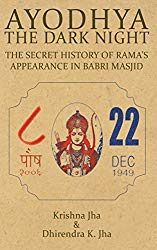“Ayodhya: The Dark Night” is a book by the journalists Krishna Jha and Dhirendra K. Jha telling the story of that fateful night of 22nd December 1949 when a bunch of Hindu activists smuggled in an idol of Rama into the Babri Masjid in Ayodhya. This act started a chain of awful events that led to several communal riots across India in the recent past and most recently led to a historic judgement by the Supreme Court of India in the dispute. This book is an essential read to understand the conspiracy among various actors as well as the collusion and apathy at multiple levels of the administration and judiciary that led to the events of that night.
While none of the primary actors in the conspiracy are alive any more, the authors managed to track down and talk to several first-hand witnesses in order to reconstruct the events. They also conducted extensive research among the various archives to get supporting material and provide copious references to these as notes towards the end of the book. Despite that, the writing in the book is thankfully not dull and the narrative is quite engaging. The conspiracy involved a cast of characters that the authors take pains to provide some background on, while exploring their respective motivations.
The book illustrates how the notorious Hindu Mahasabha, which was previously involved with the assassination of Mahatma Gandhi, in collusion with several so-called ascetics hatched and executed the plot to install the idol inside the Babri Masjid in order to gain relevance among the majority Hindu population of the country. It also shows how the corrupt local administration of Ayodhya as well as the sympathetic administration of the state allowed this to happen and then went out of its way to prevent any action that could undo the damages. Finally, it touches upon the role of the judiciary that also went out of its way to grant the usurper the right over the disputed property and to put it in a long legal limbo. Be warned that all of this makes for a very depressing read.
If nothing else, read the book for the fascinating insights into the state of the nascent nation emerging as a newly-independent country and trying to heal the wounds from a very bloody partition. Without the independence-struggle to bind them and with the mutual distrust engendered by the recent communal riots, the Hindus and Muslims in the country had to be coaxed into engaging with the important task of nation-building. In this endeavor, the first prime minister of India Jawaharlal Nehru comes across as a very able and critical leader for the country to have had at that point as described in this book. He had his differences with his home minister Vallabhbhai Patel, who was equally critical for holding the young country together, but who was sympathetic to the Hindu conservatives both within and without Congress. This is the kind of material that you will never find in the history text-books taught in your school.
The book mentions that until recently multiple locations in Ayodhya were claimed to be the birthplace of Rama and the claim for the primacy of this particular location is entirely arbitrary without any historical or mythical evidence to back it up. In fact, until that fateful night, many Hindus used to believe that the raised platform called “Ram Chabutara” in the outer courtyard of the complex was the birthplace of Rama and used to offer their prayers there. There is even some dispute over whether the modern city of Ayodhya is indeed the same as the one mentioned in the epic Ramayana. However, the book does not provide much details on the history of the Babri Masjid itself or on the previous attempts at constructing a temple there. This makes the narrative a bit too narrow for my taste and prevents the lay reader from gaining a broader historical perspective.
In the light of recent historic events related to the Ayodhya dispute, it is important for us Indians to get some unbiased historical perspective on the chain of events that have led us here. Books like these are thus vital in expanding our understanding. This book in particular is a recommended read on the topic.
